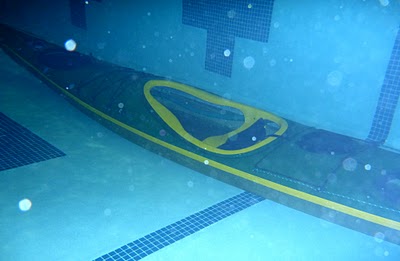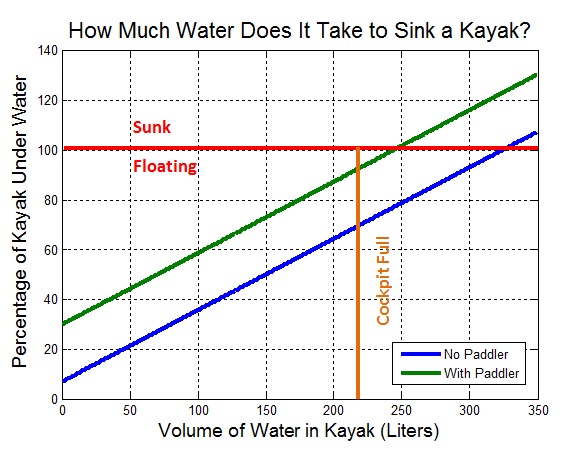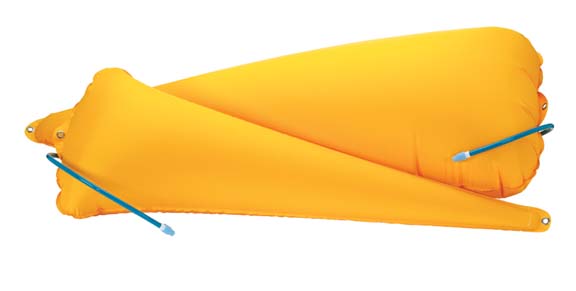Kayaks are designed to float with their occupants and their gear above the water’s surface where they can enjoy the scenery and paddle merrily along their way. However, as the picture below alludes, kayaks are certainly not impervious to sinking. The goal of this article is to examine what it takes to sink a kayak and how you can prevent this from happening.
The Physics of Buoyancy:
In the spirit of Sheldon (the uber-geek from the Big Band Theory) we’ll start our discussion on the physics of buoyancy from the beginning. Archimedes of Syracuse, the Greek philosopher and “Eurika”-screaming streaker, was certainly a brilliant and interesting man. As the father of hydrostatics, his most acclaimed contribution to science may be his work on the concept of buoyancy which he published in his treatise “On Floating Bodies.” Archimedes Principle of Buoyancy states that:
“Any object, wholly or partially immersed in a fluid is buoyed up by a force equal to the weight of the fluid displaced by the object.”
The amount of water displaced by an object can be visualized by filling a bucket with water to the brim and floating a block of wood (object) on top. The volume of water that overflows from the bucket is the volume of water that has been displaced by the block of wood. If you weight the displaced volume of water (Wwater) then you will find that it weighs more than the block of wood (Wobject). In general:
- An object floats if Wwater > Wobject
- An object sinks if Wobject > Wwater
- An object is neutrally buoyant if Wobject = Wwater
We experience Archimedes Principle each and every time we sit in our kayaks. The water that we displace weighs more than the paddler and the kayak so we float with most (but not all) of the kayak above the waterline. However, many of us have also noticed that our kayaks sit a little deeper in the water when loaded down with camping gear or when the cockpit scoops up some water during a capsize. What does it take to actually sink a kayak? This is best explained with an example:
What Does it Take to Sink a Kayak??
Let’s consider a male of average mass (80kg) paddling a Venture Capella 166 (ideal paddler mass: 65-120kg) as the subject for this experiment. Note that the density of water is 1kg/L.
In order to determine at what point a kayak will sink we must start by defining the forces acting on the kayak. The free body diagram of a floating kayak shown above includes the force of buoyancy (Fb) acting upward and the force of gravity (Fg) [weight of the kayak, paddler, gear and water added to the kayak] acting downward. The sum of these two forces must equal zero because the kayak is not accelerating in the vertical dimension. This force balance is expressed mathematically in Equation 1 where Wwd weight of the water displaced, Wk is the weight of the kayak, Wp is the weight of the paddler, and Wwk is the weight of the water added to the inside of the kayak.
Our goal is to re-write this force balance in terms of the volume of water displaced and the volume of water added to the inside of the kayak. This is accomplished by expanding the weight terms as shown in Equation 2. The weight of a solid object (kayak and paddler) can be expressed as the product of mass (m) times gravitational acceleration (g). The weight of a fluid (water) can be expressed as the product of its density (ρ), volume (V), and g.
Next, we can simplify the expression by dividing all terms by g to eliminate this shared term (Equation 3).
Now solve for the volume of water displaced (Vwd) as a function of the volume of water added to the kayak (Vwk). The rest of the terms are constants where ρw = 1kg/L, mk = 24.5kg, and mp = 80kg (average mass of an adult male).
The volume of water displaced (Vwd) is equivalent to the volume of the kayak that lies beneath the waterline! This allows us to write Equation 5 where we define %uw, the fraction of the kayak’s volume that lies beneath the waterline, as the ratio of the volume of displaced water to the total volume of the kayak (in this case 349L).
This fraction can be used to determine if the kayak floats or sinks:
- The kayak floats if %uw < 100%
- The kayak sinks if %uw > 100%
- The kayak is neutrally buoyant if %uw = 100%
In this experiment we fill the Capella 166 with increasing volumes of water (Vwk) and use Equations 4 and 5 to calculate the fraction of the kayak’s volume that lies beneath the waterline. The results are shown in the graph “How Much Water Does It Take to Sink a Kayak?” below.
The blue line represents the case where the kayak is being filled with water without the paddler in the cockpit. The green line represents the case where the kayak is being filled with water while the paddler is seated in the cockpit. Starting at the left-hand side of the graph we note that in both cases most of the kayak’s volume is above the waterline when the kayak is completely dry. As water (weight) is added into the kayak more and more of its volume begins to exist beneath the waterline.
In both cases there’s a point where a critical volume of water is added that causes the kayak to sink. This occurs at 250L (with paddler) and 325L (without paddler) when the respective green and blue lines cross the red line in the graph. The significance of this observation is that the kayak will sink before its entire volume is full of water!
What can I do to prevent my kayak from sinking?
The fact that it’s possible to sink your kayak may be alarming but there’s also some good news that comes in the form of bulkheads. In our example, the Capella 166 has three, watertight bulkheads which limit the volume of the cockpit to 216L (represented by the orange line on the graph) or roughly 62% of the kayak’s total volume. Even if you fill the entire cockpit this limited volume of water does not weigh enough to sink the kayak. The kayak will continue to float albeit with markedly decreased stability which will make climbing back in fairly tricky!
This brings me to the crux of this article. Our experiment shows that the key to preventing your kayak from going to the bottom is to limit the volume of water that can enter the kayak in the worst case scenario (capsize). The best way to do this is to purchase a kayak with fore and aft bulkheads which will act to limit the cockpit volume as in the example presented above. Make sure to inspect the bulkheads and hatch covers regularly to ensure that they remain watertight. If your kayak doesn’t have bulkheads then you should consider installing float bags in the bow and/or stern in order to limit the volume of water that can enter the kayak.
There’s no doubt that sinking a kayak is an unlikely event that may occur in extreme or otherwise preventable situations. However, as this article proves, it is possible for a kayak to sink so make sure to check those bulkheads, install float bags if needed, and always wear your PFD!
Happy Paddling!
-Kayak Dave











4 Responses to Can You Sink a Kayak?